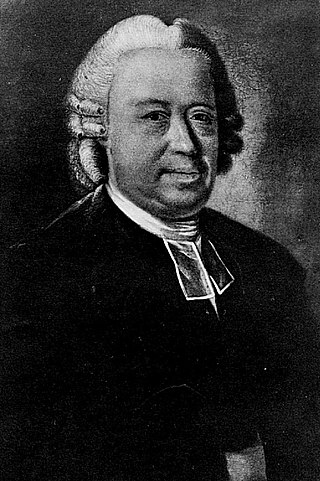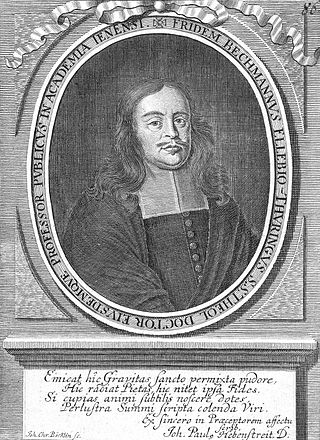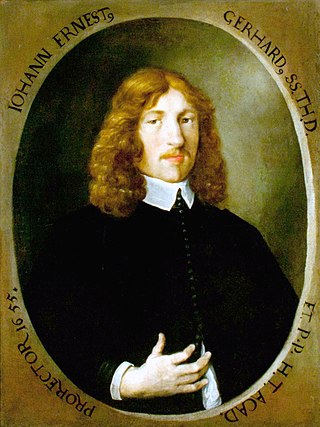Bar form is a musical form of the pattern AAB.

Johannes Pfefferkorn was a German Catholic theologian and writer who converted from Judaism. Pfefferkorn actively preached against the Jews and attempted to destroy copies of the Talmud, and engaged in a long running pamphleteering battle with humanist Johann Reuchlin.
Austerlitz is the name of a Jewish family. As is the case with all names derived from places, the surname "Austerlitz" does not necessarily signify that all the persons so named belong to one family. The name originated in Austerlitz (Slavkov), Moravia.

Johann David Köhler was a German historian. His academic focuses were on Roman coins as historical artifacts, ancient weapons, and genealogy. Köhler also served as university librarian at Altdorf and contributed to the early library science literature.
Johann Peter Spaeth, also known as Moses Germanus or Moses Ashkenazi was an Austrian theologian that converted to Judaism.
Raymond Martini, also called Ramon Martí in Catalan, was a 13th-century Dominican friar and theologian. He is remembered for his polemic work Pugio Fidei. In 1250 he was one of eight friars appointed to make a study of oriental languages with the purpose of carrying on a mission to Jews and Moors. He worked in Spain as a missionary, and also for a short time in Tunis. A document bearing his signature and dated July 1284 shows that he was at that time still living.
Anton Margaritha was a sixteenth-century Jewish Hebraist and convert to Christianity. He was a possible source for some of Martin Luther's conception of Judaism.
A Christian Hebraist is a scholar of Hebrew who comes from a Christian family background/belief or is a Jewish adherent of Christianity. The main area of study is that commonly known as the Old Testament to Christians, but Christians have occasionally taken an interest in the Talmud and the Kabbalah.
Johan Kemper (1670–1716), formerly Moshe ben Aharon Ha-Kohen of Kraków or Moses Aaron, baptized Johann Christian Jacob; was a Polish Sabbatean Jew who converted from Judaism to Lutheran Christianity. His conversion was motivated by his studies in Kabbalah and his disappointment following the failure of a prophecy spread by the Polish Sabbatean prophet Zadok of Grodno, which predicted that Sabbatai Zevi would return in the year 1695/6, It is unclear whether he continued to observe Jewish practices after his conversion.
David Caspari was a German Lutheran theologian. He was the father of Georg Caspari.
Behr Shmuel Issachar Leyb ben Judah Moses Eybeschuetz Perlhefter was a Jewish scholar and rabbi. His educated wife Bella bat R. Jakob Perlhefter, corresponded in Hebrew and wrote the preface on the Yiddish book “Beer Sheva”. Perlhefter taught the German Christian Hebraist Johann Christoph Wagenseil Hebrew and Jewish literature. Beer Perlhefter is considered an important figure of the Sabbatian movement. After the death of the pseudo-Messiah Sabbatai Zevi (1626-1676), he restored the Sabbatian theology at the school of Abraham Rovigo and called the Pseudomessiah Mordecai Mokiach to Italy.

The history of the Jews in Regensburg, Germany reaches back over 1,000 years. The Jews of Regensburg are part of Bavarian Jewry; Regensburg was the capital of the Upper Palatinate and formerly a free city of the German empire. The great age of the Jewish community in this city is indicated by the tradition that a Jewish colony existed there before the common era; it is undoubtedly the oldest Jewish settlement in Bavaria of which any records exist.

Christian Wilhelm Franz Walch was a protestant German theologian and professor of theology from Göttingen. He authored numerous books.
As Thomaskantor, Johann Sebastian Bach provided Passion music for Good Friday services in Leipzig. The extant St Matthew Passion and St John Passion are Passion oratorios composed by Bach.
Rudolph Bernhard, originally rabbi Jacob Levi of Prague, was a Christian writer. He was baptised at Berne in 1694. In 1705 he published the proselytizing letter Sendschreiben: Geschrieben an die so genannten Juden. When he died he left a manuscript translation in Hebrew of Matthew, Mark, and Luke up to chapter 16:31.
Rudolf Martin Meelführer (1670–1729) was a German Hebraist. He was a student of Wagenseil at the University of Altdorf, and followed his teacher in study of the depiction of Christianity in the Talmud. He taught at Altdorf and then was adjunct in philosophy at Wittenberg.
Bella bat Jakob Perlhefter was a professional Hebrew letter writer, businesswoman and instructor of music. She corresponded with her husband Behr Perlhefter and with the Christian polymath Johann Christoph Wagenseil in Hebrew. She wrote the preface of the Yiddish book “Beer Sheva”.

Friedemann Bechmann was a German Lutheran theologian.

Johann Ernst Gerhard was a German Lutheran theologian. There are suggestions, however, that his greater scholarly passion lay in Oriental studies.
Bella Ḥazzan, née Horwitz, was an 18th-century Bohemian Yiddish writer.






